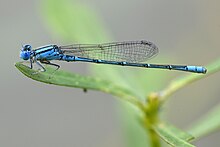| Eastern lilysquatter | |
|---|---|

| |
| Male | |
| Conservation status | |
 Least Concern (IUCN 3.1) | |
| Scientific classification | |
| Domain: | Eukaryota |
| Kingdom: | Animalia |
| Phylum: | Arthropoda |
| Class: | Insecta |
| Order: | Odonata |
| Suborder: | Zygoptera |
| Family: | Coenagrionidae |
| Genus: | Paracercion |
| Species: | P. melanotum |
| Binomial name | |
| Paracercion melanotum (Selys, 1876) | |
| Synonyms | |
| |
Paracercion melanotum, also known as the eastern lilysquatter, is a species of damselfly in the family Coenagrionidae. It is known to occur in China, Taiwan, South Korea, Japan, Vietnam, India, Sri Lanka, Nepal, Java, Philippines and Thailand.
Taxonomy
Species delimitation study based on COI, ITS, and morphological evidence concluded that P. pendulum and P. malayanum were synonymized as junior synonyms of P. melanotum.
Description and habitat
It is a medium sized damselfly with deep blue eyes. Its thorax is black on dorsum with very broad azure blue antehumeral stripes, which are very narrow or missing in Paracercion calamorum. Lateral sides of thorax are blue with a fine black line on the upper part of each lateral suture. No pruinescence compared to P. calamorum. Its wings are transparent and pterostigma is yellow, framed with heavy black nervures. Its abdomen is azure blue with broad black dorsal marks up to segment 7. Segment 2 has a distinct broad dorsal spot shaped like a thistle-head connected narrowly to a fine apical ring. This mark will help to distinguish it from Pseudagrion species. Segment 10 has a narrow mid-dorsal black streak. Female is dull green in colors. Its abdomen is similar to the male. But the lateral ground colour is yellowish red and segments 8 and 9 are broadly black on dorsum. Segment 10 is blue only in the apical border.
It breeds in shallow lakes, ponds and paddy fields in the lowland, perches on the floating vegetation.
See also
References
- ^ Wilson, K. D. P. (2009). "Paracercion melanotum". IUCN Red List of Threatened Species. 2009: e.T167159A6309807. doi:10.2305/IUCN.UK.2009-2.RLTS.T167159A6309807.en. Retrieved 14 March 2023.
- Paulson, D.; Schorr, M.; Abbott, J.; Bota-Sierra, C.; Deliry, C.; Dijkstra, K.-D.; Lozano, F. (2024). "World Odonata List". OdonataCentral, University of Alabama.
- Zhang, H; Ning, X; Yu, X; Bu, W (2021). "Integrative species delimitation based on COI, ITS, and morphological evidence illustrates a unique evolutionary history of the genus Paracercion (Odonata: Coenagrionidae)". PeerJ. 9: e11459. doi:10.7717/peerj.11459. PMC 8164416. PMID 34123590.
- ^ C FC Lt. Fraser (1933). The Fauna of British India, including Ceylon and Burma, Odonata Vol. I. Red Lion Court, Fleet Street, London: Taylor and Francis. pp. 375-376.
- Subramanian, K. A. (2005). Dragonflies and Damselflies of Peninsular India - A Field Guide.
- "Paracercion malayanum Selys, 1876". India Biodiversity Portal. Retrieved 2017-03-03.
- "Paracercion malayanum Selys, 1876". Odonata of India, v. 1.00. Indian Foundation for Butterflies. Retrieved 2017-03-03.
External links
![]() Data related to Paracercion melanotum at Wikispecies
Data related to Paracercion melanotum at Wikispecies
![]() Media related to Paracercion melanotum at Wikimedia Commons
Media related to Paracercion melanotum at Wikimedia Commons
| Taxon identifiers | |
|---|---|
| Paracercion melanotum | |
This article related to Coenagrionidae is a stub. You can help Misplaced Pages by expanding it. |